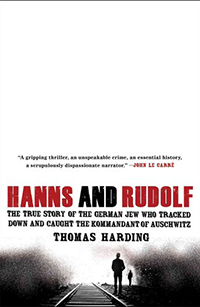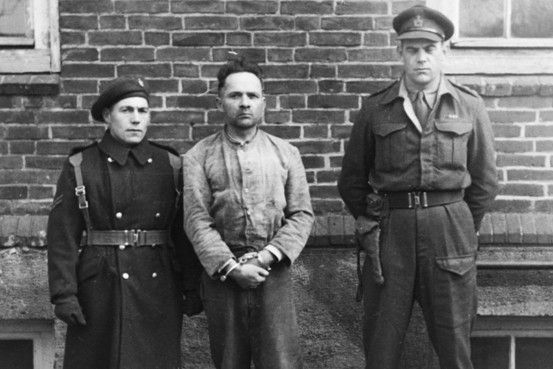Hanns and Rudolf
Over the Christmas break, we made a life-changing addition to our room – a lamp. Until now, our only light came from the overhead light or the master bathroom. The overhead light is not pleasing, and worse it requires the overhead fan to be on – not optimal for winter evenings.
The lamp is making it much easier to read, which leads me to my topic today.
 I read this week, Hanns and Rudolf: The True Story of the German Jew who Tracked Down and Caught the Kommandant of Auschwitz by Thomas Harding. It simultaneously tells the story of Hanns Alexander who tracked and caught Rudolph Hoss immediately following World War II, and Hoss (pronounced Hess), who was placed in charge of devising the means of the “Final Solution” (what we know as the Holocaust).
I read this week, Hanns and Rudolf: The True Story of the German Jew who Tracked Down and Caught the Kommandant of Auschwitz by Thomas Harding. It simultaneously tells the story of Hanns Alexander who tracked and caught Rudolph Hoss immediately following World War II, and Hoss (pronounced Hess), who was placed in charge of devising the means of the “Final Solution” (what we know as the Holocaust).
It’s just as fascinating and depressing as it sounds.
One fateful decision.
Reading Hanns and Rudolf is like watching a movie where you know the outcome, but you are hoping for something different. While I was saddened by what happened to Hanns (his wealthy family self-exiles to Britain and never financially recovers), I truly grieved for Rudolph.
Rudolph was a kid who grew up without much of a chance of survival, lost his overbearing father as a young teen, and didn’t have means to propel him forward in life. Hoss fought in WWI and then as a mercenary after the war. He didn’t gain much but jail time.
When he was released, he began to find his bearings as a farmer then as a husband and father. Rudolph is just beginning to live his dream.
The Rise of the SS
As Rudolph began moving forward in life, Adolf Hitler and his regime came to power. The Nazi’s established the SS early in it’s political process, but after Hitler took power, it became necessary to be a member of the SS in order to be used as a vendor.
Hoss made 2 fateful decisions in 1933 and 1934.
First, in September 1933, Rudolph applied to join the SS in order to grow his business – a horse farm. He didn’t agree with the entire world view of Hitler or Heinrich Himmler (the leader of the SS), but Hoss believed he needed this stepping stone to gain success.
Second, and probably the more important, in June 1934, Hoss joined the SS as an active soldier (not as a horse rancher).
Hoss already met Himmler through the army where they bonded over farming. Himmler saw Hoss being sworn in 1933, and personally recruited him to train as a supervisor at his political concentration camps.
Hoss and his wife, Hedwig, were torn. They knew this could provide the means for them to purchase their own farm, but it would take them from the idyllic life they had just started to realize.
Time stood still…
This part of the story takes less than a page to recount, yet for me it was as if everything stopped. I wanted to scream, “Don’t do it!”
It was the linchpin moment.
Everything rose and fell for the Hoss family with this decision.
Ultimately, it all fell. Rudolph was quickly indoctrinated into the brutality of camp life, and he fell in line. He climbed the ladder, successfully building and running Auschwitz, then building facilities to kill over 2,000,000 lives in a matter of months.
The family went on the run in 1945.
As you know from the title of the book, Rudolph was caught. He was tried and killed in 1946.
Emotionally, his family never recovered. They tried to bury the memory of Hoss with his body, but his ghost wouldn’t leave them.
In the epilogue, author Thomas Harding visits Auschwitz with one of Rudolph’s grandson’s and ex-daughter-in-law’s (who he never knew). She married his son knowing nothing of the history. She was made aware sometime during their marriage, and she was asked about it by Harding (why she stayed with him).
She responded, “When I was getting married in church, I said until death, with sickness, with health, I say with him for twenty-seven years. He no happy.”
They knew.
Over 2 million people walked through the camp and never walked out…most in a matter of hours. Rudolph knew. Hedwig knew. The family knew. They may not have really understood, but they knew.
They tried to bury it, but it wouldn’t really die. Why? They knew.
And it all started with 2 fateful decisions in the fall of 1933 and summer of 1934. It destroyed their lives. Over the last 65 years, this family rebuilt, but they aren’t completely free, and it started with 2 decisions.
You know. I know.
Sometimes it may seem impossible to know where a decision in life will take us (#1), but other times it’s much more clear (#2).
Kia and I have made a number of huge decisions over the last 2 years. Some of them were innocent, but far reaching none the less.Others we were well aware of the impact they would have in our life.
The important thing is we’ve taken ownership of these decisions. She knows. I know. We know.
What decisions are you facing in life? Where will they take you? Do you know?



Leave a Reply